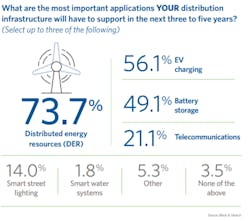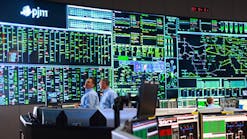Report Shows Utilities Doubling Down on Modernization
Technology Breathing New Life into Utilities
Technology is transforming our industry at a rapid rate and reshaping how customers both consume energy resources and interact with their utilities. “Digital technology and network advancements are breathing life into utilities’ aging distribution systems. Distributed energy resources (DER) and renewable energy are challenging traditional business models and centralized generation. Economical advances in energy production, storage and control are giving rise to the prosumer, driving consumer choice and ultimately producing a new energy marketplace at the local distribution level.” John Janchar, president of Black & Veatch’s telecommunications business recently shared.
As an industry, we must embrace distribution modernization to develop an autonomous, interactive grid edge, which is paramount to satisfy tomorrow’s energy demands. Roughly one of every five respondents say their utility plans to pour more than US$200 million into modernization over the next three years. An additional 26% report they’ll devote US$100 million to US$200 million to that cause. The drivers of the investments that utilities are making in distribution system modernization stem, perhaps ironically, from assets that utilities often don’t own, namely DER such as rooftop solar arrays, electric vehicles and battery energy storage systems. To make these investments valuable, utilities can use monitoring, control, and automation technologies to unlock the full potential of grid assets for greater reliability, efficiency, and security.
Network Management Services
Advocates of the internet of things (IoT) and other integrated technologies have done an admirable job of selling utilities on the value of smart devices. “With applications before and behind the meter, network intelligence strategies involving advanced metering infrastructure (AMI) and other technologies are carrying the promise of unprecedented volumes of data about customer habits, asset health, system outages and other anomalies. A key question that still persists for our industry, though, is how to best manage the network.” John Janchar explained. Some leading utilities have taken an approach to develop an integrated network management system (INMS) to serve as a “manager of managers” to enable a single, end-to-end vision of all the devices and services that are being delivered by the network.
Whole Systems Asset Management and DER Market Enablement
Utilities are working to increase monitoring, improve reliability, and integrate DERs to bring a massive new array of assets online in the distribution space. Along these lines, they also recognize that a new organizational body will help manage market enablement.
“Consumers are empowered and becoming more technologically savvy and digitized by the day, thanks to the rise of smart metering and other intriguing gadgetry like smartphone apps that give them more control and functionality over their energy. They also can readily switch between suppliers and pressure utilities to prize customer service to stifle customer attrition or the potential fallout of bad publicity on influential, broad social media.” said John Janchar. Utilities that embrace grid modernization will have the knowledge, control and tools to engage customers and offer the accessibility they are growing to expect.
As our series continues, we will explore other key findings and share additional comments from our leaders. To read the most recent editions of our Strategic Directions Report, visit bv.com/reports.




